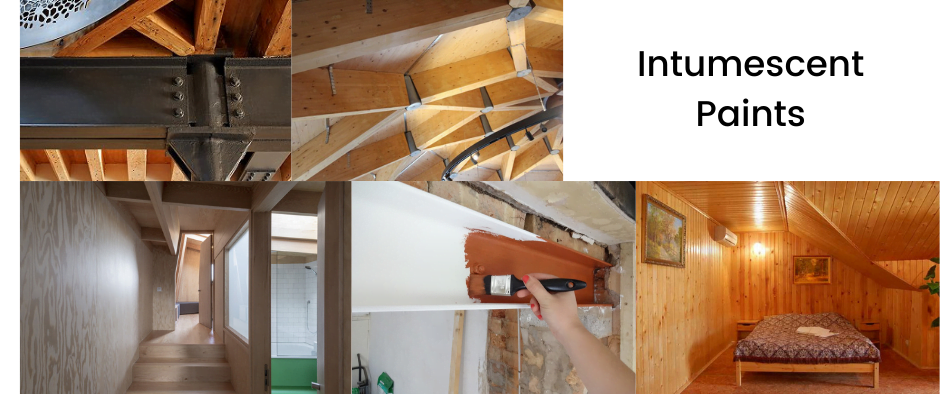
Intumescent Paint: How Does It Work And Why Is It Needed?
Intumescent Paint Definition
Intumescent paints are what we refer to as “Reactive Paints”. When the paint is subjected to heat it will react. In the case of an intumescent paint, when subjected to temperatures exceeding 120°C the paint will intumesce (swell up to 50 times the thickness of the paint) and form a carbon layer (Char) which, thermally insulates the material for a given period of time: 30, 60, 90 or 120 minutes.
Why Is It Needed?
In a fire it is critical that the structural frame of the building is protected correctly so that the materials do not reach their critical failure temperature, potentially causing the building to collapse. Intumescent paint not only prevents this from happening, but it slows down the spread of a fire, giving more time to evacuate buildings safely and thus potentially saving lives.
In summary, intumescent paint thermally insulates structural materials such as steel and timber in a fire, stopping premature collapse of the building and slowing down the fire.
Intumescent paint comes in three different types: steel, timber and plaster:
- Steel: Intumescent steel paint is designed to increase the time period that a structural load bearing steel within a building will last during a fire. The paint works by intumescing or expanding to create an insulation barrier on the steel and increasing the time period to 60, 90 or 120 minutes. During a fire it can just take a few minutes for the temperature of unprotected steel work to reach 550°C. At this point steelwork loses its structural load bearing capacity and can buckle causing a building to potentially collapse. By correctly protecting steel, it exists in a state of ‘Elasticity’ which allows the steel to bend/deflect and return to its original state once the force has been removed.
Recommended: Nullifire SC802 Intumescent Basecoat is a water-based, white, thin film intumescent coating for the protection of internal structural steelwork & can provide up to 60 minutes fire resistance. View More -> - Timber: Intumescent paint and Intumescent varnish for timber is designed to increase the fire performance of the timber substrate in two different ways, firstly it can decrease the surface spread of flame to a British Class 0 and also a Euro Class B and secondly on substrates of a minimum thickness we can increase the fire performance to 30 minutes or in some cases 60 minutes.
Recommended: Sika Pyroplast range of intumescent paints & varnishes for wood. Sika Pyroplast Wood T provides spread-of-flame protection and delays the inflammation of internal natural wood derivates. View More -> - Plaster: Intumescent paint for plaster is designed to increase the fire performance of a lath and plaster or plasterboard wall/ceiling. Standard lath and plaster walls or ceilings are generally assumed to have a fire performance of around 20 minutes if in good condition. Our intumescent paint is designed and tested to increase the fire performance up to 60 minutes with a thickness of paint applied of just 0.25mm or ¼ of a mm.
Recommended: Envirograf EP/CP White Intumescent Paint Coating is a white, fire-resistant coating system, offering fire protection to plasterboard or lath-and-plaster ceilings and walls of various thicknesses. View More ->
Specification and Estimations for Intumescent Paint for Steel and its Application
Intumescent paints are the most common form of fire protection to steel. This is because of how widely available the products are and how cheap they are. Intumescent paints and coatings are available in Water and Solvent based forms with fire ratings of 30, 60, 90 and 120 minute utilising thin film intumescent technology and thick film intumescent technology. We can also supply non-reactive fire protection up to 4 hours using cementitious sprays or boarding systems.
Application of Intumescent steel paints is very easy. You can apply the paint using a brush or spray machine. Typically brush application is up to 500 microns per coat and spray is 1000 microns per coat. It is important that drying times are adhered to before application of the second or third coat to ensure the paint will protect the steel. During application a Wet Film Gauge is used to measure the thickness of each coat of paint. We can supply these gauges as well as the paint itself.
Do I need a topcoat?
The topcoat of an intumescent paint system is solely used to protect the intumescent coating from the environment that it is in or as a decorative finish coat that can be coloured to most RAL or BS colour codes upon request. The finish of these top coats is usually satin or gloss, however we have several products that finish in matt. Not all jobs jobs require a topcoat, however if the steel is external or internal in a high moisture environment then yes you will need a topcoat. Before buying any intumescent paint for steel you must make sure that a full specification has been undertaken listing all structural steel that need to be protected.
Call our technical department on 01752 690997 to discuss our free estimating and specification services.
To View Our Range of Intumescent Paints for fire protection up to 2 hours along with Class 0/1 and Euro Class B/C , please click here: Intumescent paint


